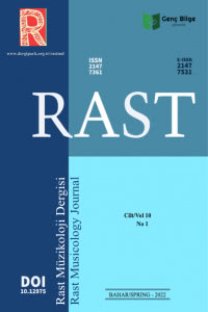Preludes and fugues for piano in the polyphonic works of Chinese composers
Chinese piano music, polyphony, Prelude and fugue, pentatonic scale, performance
Preludes and fugues for piano in the polyphonic works of Chinese composers
Chinese piano music, polyphony, Prelude and fugue, pentatonic scale, performance,
___
- Bai Ye. (2018). Conceptual Models of Chinese Piano Music Integration into the Space of Modern Music. International Review of the Aesthetics and Sociology of Music, Vol. 49, No. 1 (June 2018), pp. 137-148. https://www.jstor.org/stable/26844635 Chapin, К. (2010). Time and the Keyboard Fugue. 19th-Century Music, Vol. 34, No. 2 (Fall 2010), pp. 186-207 Published by: University of California PressStable URL: http://www.jstor.org/stable/10.1525/ncm.2010.34.2.186.
- Fan, Zuyin (2004). Folk musical polyphony of China. Beijing.
- Igarashi, Yuki & Ito, Masashi & Ito, Akinori. (2013). Evaluation of Sinusoidal Modeling for Polyphonic Music Signal. 2013 Ninth International Conference on Intelligent Information Hiding and Multimedia Signal Processing Publisher: IEEE, Beijing, China, 464-467. DOI: 10.1109/IIH-MSP.2013.121.
- Li, Hong. (2015). The Practice of Integration Guangxi Polyphonic Folk Music into Chorus Singing Teaching for Normal University Students. International Conference on Advanced Education and Management (ICAEM 2015), 488-492.
- Li, Xiaoquan & Yan, Yijun & Ren, Jinchang & Zhao, Huimin & Zhao, Sophia & Soraghan, John & Durrani, Tariq; Liang, Qilian & Mu, Jiasong & Jia, Min & Wang, Wei & Feng, Xuhong & Zhang, Baoju, eds. (2018). Knowledge based fundamental and harmonic frequency detection in polyphonic music analysis. Communications, Signal Processing, and Systems. Springer, CHN, 591-599. ISBN 9789811065705.
- Mann, A. (ed.) (1971). The study of Counterpoint from Johann Sebastian Bach Fux’s Gradus ad Parnassum. W.W.Norton & Company, New York.
- Mann, A. (1987). The Study of Fugue (Dover Book on Musik). Dover publications, New York.
- McGahie, D. Р. (2006). The choral fugue: A comparative study of style and procedure in works by J. S. Bach and W. A. Mozart. (Abstract of the thesis … DMA), University of Cincinnati.
- Peng, Cheng (2006). The Chinese Traditional Modal System and Its Application in the 20th Century: A Study. Moscow: Moscow State Pedagogical University.
- Pesic, P. (2017). Polyphonic Minds: Music of the Hemispheres. The MIT Press Cambridge, Massachusetts, London.
- Sun, Wei-bo. (2006). Polyphonic Cycle in the Piano Creativity of Chinese Composers: Tradition and Innovation. (Abstract dissertation. candidate of art history). Belarusian State Academy of Music, Minsk.
- Wei, Tingge. ed. (1998). Selection from Chinese Classical Music for Piano № 2. Editors-in-Chif: Wei Tingge, Li Mingjun, Xu Min. ShiDaiWenYi Publishing House, Shanghai.
- Williams, Р. (2003). The Organ Music of J. S. Bach. Ed. 2. Cambridge U. Press.
- Wu, Na. (2009). Ding Shan Te's Piano Music: Combining Chinese National Tradition with Modern Methods of European Writing. (Abstract of the dissertation of a candidate of art history). St. Petersburg N. A. Rimsky-Korsakov State Conservatory. St. Petersburg.
- Weiwei, Zhang & Zhe, Chen & Fuliang, Yin. (2016). Main melody extraction from polyphonic music based on modified Euclidean algorithm. Applied Acoustics Volume 112, 70-78. https://doi.org/10.1016/j.apacoust.2016.04.023
- Ying, Jiang. (2019). Reviving the Beauty of Bach's Music — On the Teaching of Bach's Polyphonic Works. Advances in Social Science, Education and Humanities Research, volume 322 2nd International Seminar on Education Research and Social Science (ISERSS 2019). Series Advances in Social Science, Education and Humanities Research. Atlantis Press, 156-159. https://doi.org/10.2991/iserss-19.2019.41
- ISSN: 2147-7361
- Yayın Aralığı: Yılda 4 Sayı
- Başlangıç: 2013
- Yayıncı: Genç Bilge Yayıncılık (Young Wise)
Vokalist mi yoksa oyuncu mu: Müzikal tiyatro türünde hangisi daha iyi performans göstermeye hazır?
Marina KRUGLOVA, Anna SHCHERBAKOVA, Aigul GAREEVA, Alexander VASİLENKO
Balina Şarkısı: Kambur Balina Megaptera Novaeangliae Kültürlerinde Müzikal Pratikler
Shqipe AVDIU-KRYEZİU, Arsim AVDİU
Preludes and fugues for piano in the polyphonic works of Chinese composers
Marianna CHERNYAVSKA, Mengzhe ZHANG
V.R.'nin “Game” şarkısının taslak versiyonlarında özne-nesne ilişkileri kavramı. Tsoy
Çocuğun sosyalleşme süreci olarak yaratıcı sanatsal ve müzikal etkinliği
Irina Vladimirovna WAGNER, Ekaterina Mikhailovna AKİSHİNA, Elena Petrovna OLESİNA
The Effect of Playing Instrument on Voice Training
V.R.'nin “Game” şarkısının taslak versiyonlarında özne-nesne ilişkileri kavramı. Tsoy
